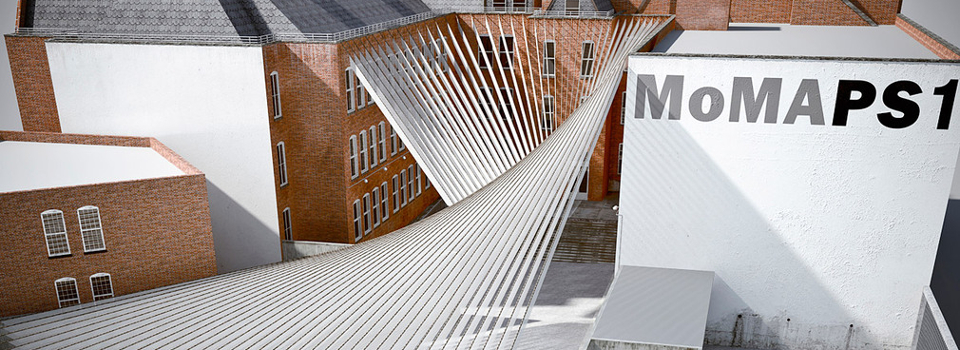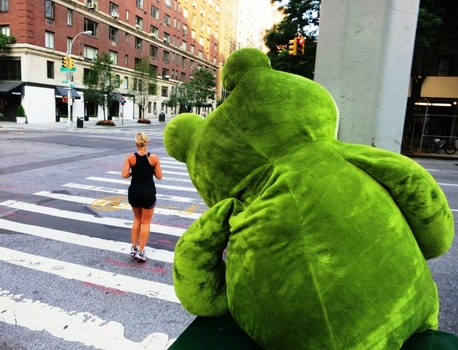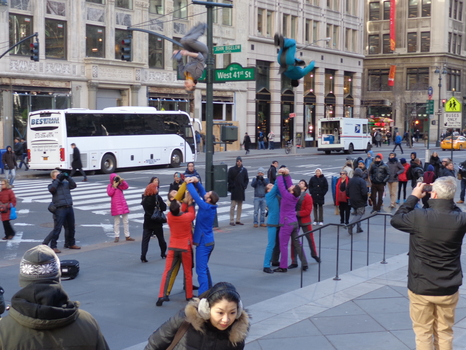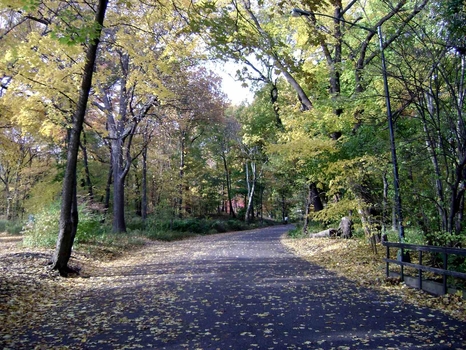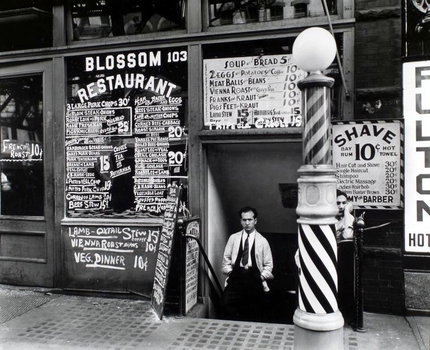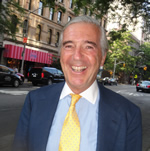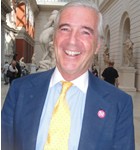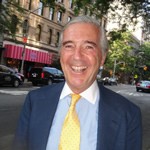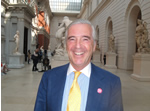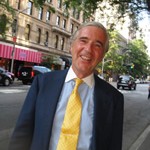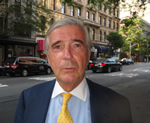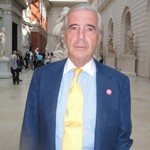Ask a New Yorker: We are here today at the Metropolitan Museum of Art with…
Joep: Joep de Koning from New York, but originally from the Netherlands. I’ve
lived in New York City for 44 years.
Ask a New Yorker: You’re practically a native. Did you go out to
Maxwell Plumb, Studio 54 and Plato’s Retreat?
Joep: I did not go to Plato’s, that was not my style. But Maxwell Plumb
was fine.
Ask a New Yorker: You posted a project you were working on in 2002 on Ask a
New Yorker. Are you still working on it?
Joep: Absolutely, and without any let-up. 12-14 hours a day.
Ask a New Yorker: That’s a lot of hours.
Joep: 57,000 hours since 1997, to be precise.
Ask a New Yorker: What the hell are you doing? Tell us about this project.
Joep: It’s a long haul.
Ask a New Yorker: Sounds a little obsessive.
Joep: It’s passion.
Ask a New Yorker: Anthony Weiner is obsessive.
Joep: I would say he was pretty compulsive, and rather a bit indecent. I’ve
written the man at least 100 times over the years but he’s too busy sending
photographs of himself to other people. So he can’t answer me. What do
you do? You just wait until they finish sending their photographs to girls all
over the country.
Ask a New Yorker: Please tell us about this project.
Joep: The project basically is about the foundation of New York City, if not
the State of New York. It has to do with the concept of liberty. Where does
liberty come from? It germinates from the concept of tolerance. I’m talking
about religious tolerance but also ethnic and racial tolerance. I am sure you
know that in an intolerant culture, liberty-for-all won’t be possible.
Now, the juridical notion of religious tolerance was planted first in North
America on Governors Island in 1624. The legislature finally decided upon recognizing
the island in May 2002 as New York State’s birthplace. So that took me
5-6-years to get that done. Now I’m trying to transform that birthplace
into a national symbol. It will be America’s symbol of tolerance as the
foundation of American liberty. http://www.tolerancewalk.com/
Ask a New Yorker: A tourist destination.
Joep: It’s an incredible tourist destination because liberty, basically,
goes undefined. The Statue of Liberty stands there but an easy definition of
what liberty means to you and me is lacking, it’s just a static notion.
Liberty can only be defined through the active notion of tolerance because tolerance
is a two-way street. It requires something from you, at the very minimum respect.
I call it a reciprocal dynamic. Then, Tolerance Island and Liberty Island as
fraternal twins become the visual manifestation of American freedom, its supreme
underpinning.
Ask a New Yorker: Real estate developers are lining up for this prize piece
of real estate. Nonprofits vs. the private sector, it sounds like a whopper
of a challenge.
Joep: Not for profit does not mean a sink hole as currently planned by officials
as per their press releases. You can make profits like for instance the non-profit
Metropolitan Museum which gets over 4 million visitors per year. It’s
basically self-sustaining. You can expect at least an equal number of visitors
to the Tolerance Park on Tolerance Island/Governors Island as to Liberty Island.
Liberty Island gets already over 4 million visitors a year. So if you can get
4 million visitors to the Tolerance Island and you build a Tolerance Monument
as Liberty’s equal partner in the conception of America’s freedom,
then you can financially sustain that easily, for centuries.
Ask a New Yorker: You’re very knowledgeable on the history of New York.
What are your credentials, educational background?
Joep: The credentials lie obviously in the person. My education is I went to
college, which was called The Academy of Arts in the Netherlands. I basically
graduated in graphic communications, which was really not my dream in life.
My dream was to be the Dutch David Ogilvy of Madison Avenue. So through England,
where I studied business, I came to America in 1968 and started in advertising
here. I spent four years in advertising on liquor and consumer packaged goods
then I transformed myself into a financier by going to Columbia business school.
I majored in Finance there. I then worked for commercial banks, an investment
bank and I had my own private equity firm.
Ask a New Yorker: No Yale in the picture. I thought I read something about
a PhD in History.
Joep: No Yale, Just Columbia University. I wouldn’t go anywhere else.
I would have considered Harvard though. It was a little harder to get in. So
my credentials are artistic, marketing, sales, analytical/financial and charitable
at the same time. I started this project in 1998 full time. I gave up my company
in order to get this done, a slam dunk obviously.
Ask a New Yorker: If you could invite any three people to have dinner with
who would they be?
Joep: A dinner party to get this done? Essential, vital to this project are
Governor Cuomo and the speaker of the Assembly,
Sheldon Silver and the majority leader of the Senate, Dean Skelos. Those
are the three. A White House blessing would help.
Ask a New Yorker: Let’s make this happen.
Joep: They won’t take my phone calls or see me and have not answered the
letters I’ve written. So I really have to go broad base and grass roots
to see whether democracy in Albany works. Whether there is anyone out there
who would be willing to take down the barricades or has the courage to penetrate
the inner sanctum.
Ask a New Yorker: I’m all about taking down barricades.
Joep: You’re speaking to a New Yorker. This is a quintessential New York
message; quintessential New York history and you can’t go any better than
this. Yet, the State and the City are mute.
Ask a New Yorker: There’s lots of synergy between the Tolerance Walk
and Ask a New Yorker.
Joep: It lies at the root of the United States of America. It has all to do
with diversity, acceptance of the full humanity of others, whether it’s
religion, race or ethnicity. What else can I say?
Ask a New Yorker: Success at anything is difficult. In your opinion, what are
the most important ingredients to succeeding?
Joep: Depends on how you define success. It is not all about money. First of
all, there are two markets out there. There is the private market and there
is the political market. They do not mix naturally unless in some sort of collusion.
The ingredients to success in the private market have to do with not only merit
or an idea but also with marketing skills, knowing people, but especially endurance.
Without endurance no idea will come to fruition, no deal will ever be made.
So you have to reach out to people and respond to them and be willing to cater
to them in their self-interest in order to get anything done. I think it is
called collaboration. Now if you’re a ballerina, you’re there only
for yourself. But if you want to be a ballerina in the American Ballet Theater
you have to reach out and not only be very good but also know the right people
to get access for the required dialogue. There is no preordained plan to prevent
such dialogue or block an applicant’s access. In the political arena success
has a different meaning. I’m a private individual without power then how
do I get access to politicians whose main interest is to maintain local power
by catering to their district’s constituents? Politicians are not willing
to speak to anyone outside their district as they could intrude accidentally
on someone else’s district. So if one would want to talk to Mr.
Jerrold Nadler for example, who is part of the US delegation and whose district
is lower Manhattan and its west side with over 650,000 constituents, how could
outsiders be heard, even if numerically large? His friends and politically entrenched
allies would block anyone from any earnest dialogue that would be in competition
to theirs. I mean they have their own program, their way or the highway. This
is also true for politically well connected activist people/groups. The private
Governors Island Alliance is essentially an arm of the Hudson River Park powers.
They receive something like fourteen million dollars annually from Albany and
the City to hold festivals and parties on Governors Island and to invite clowns,
music, and all that jazz to entertain constituents. By luring people away from
their computers on weekends they hope to meet a certain visitor quota that makes
them eligible for the next round of subsidized funding. Don’t forget,
the island is situated in Representative Sheldon Silver’s district. He
is also the Speaker of the Assembly. It seems to me that with respect to NY
State’s birthplace his allegiance is more to his district constituents
than to the people of New York State. But Tolerance Island is bigger than even
that as it is meant for over 300 million Americans and will function as a beacon
to humanity.
Ask a New Yorker: We need to get to Sheldon. What’s the biggest myth
about New York’s history?
Joep: That is a real estate myth. The story about Peter Minuit having bought
Manhattan Island from the Indians for a few kettles and beans worth sixty dollars
just didn’t happen. There was no real estate transaction. There were instructions.
These instructions were given in 1624 and 1625 to the first settlers to Governors
Island. They were led by the second Director of New Netherland called Willem
Verhulst. They were told by the Dutch government and the West Indian Company
that they had to build a citadel as permanent settlement in this region. They
could select to build that fortification in any place they would want to as
long as the place was not occupied by Indians. But if a preferred place was
already occupied by natives they had to appease them by giving them merchandise
that would allow the settlers to live among them in peace. Those were the presents
that were given to the Indians and enabled the colonists to live harmoniously
among the Manhattan Indians. The West Indian Company had suggested though that
the colonists consider a spot on the west side of the Hudson River to build
Fort Amsterdam, which is now Hoboken, or at the southern point of Manhattan.
In the end it was left up to Willem Verhulst and his council to decide where
fort Amsterdam was going to be built and they decided on Manhattan Island in
1625. Then most of the settlers moved gradually from Governors Island to Manhattan
Island. What has Minuit to do with the founding of the City?
Ask a New Yorker: Cheers to Peter Minuit.
Joep: Peter Minuit was a volunteer of the West Indian company, he was not an
employee. At the end of 1626 Willem Verhulst, the second director of New Netherland,
was sent back to the Netherlands together with the fortification engineer. They
arrived there in November 1626 on the wharf of Amsterdam. There was a parliamentary
representative from the West Indian Company that made a report. It was only
that local guy who had written down that Manhattan had been bought from the
Indians. It’s no more than a slip of the tongue or hearsay because there
is no deed and never was. He had most likely heard it from Verhulst himself
who reinterpreted his instructions as it sounded better. I guess that later
story tellers just assumed that it was Minuit who had “bought” Manhattan
because he had been elected director by the New Netherland Council to succeed
Verhulst. But Minuit wasn’t even here at the time. He had only arrived
from the Netherlands in May 1626 and went straight to what is now called Albany.
He wasn’t even in New Amsterdam in May 1626 when the so-called real estate
transaction allegedly took place.
Ask a New Yorker: Thank you for setting the story straight.
Joep: There is no proof anywhere that Peter Minuit bought the island of Manhattan
from the Indians.
Ask a New Yorker: Got it. We need to get New Yorkers involves with this powerful,
meaningful message.
Joep: New Yorkers are busy people. You walk around your neighborhood and all
at once six months later there’s a building and you’ve forgotten
what was there before. It’s a new building. People are essentially oblivious
to their surroundings. They’re too busy. It’s the same with the
concept of tolerance. There is so much tolerance here that people are not aware
of it. The question is: How do you make them aware that tolerance is not just
a pragmatic idea that results from commerce and diversity but how do you make
it an idealistic concept, America’s ultimate virtue that is at the forefront
of liberty for all. Not just accepted by default by busy New Yorkers but purposely
realized as innate to American freedom, also by rural people in Idaho, North
Dakota or Alabama? That is what I’m trying to accomplish. I’m trying
to make the concept of tolerance as the basis of successful diversity and the
foundation of liberty understood by all. The creation of the Tolerance Park
would make this universal value of tolerance become visible through broad awareness
and conscious vigilance.
Ask a New Yorker: What a pleasure connection after all these years. You’re
a good man Joep. All the best.

